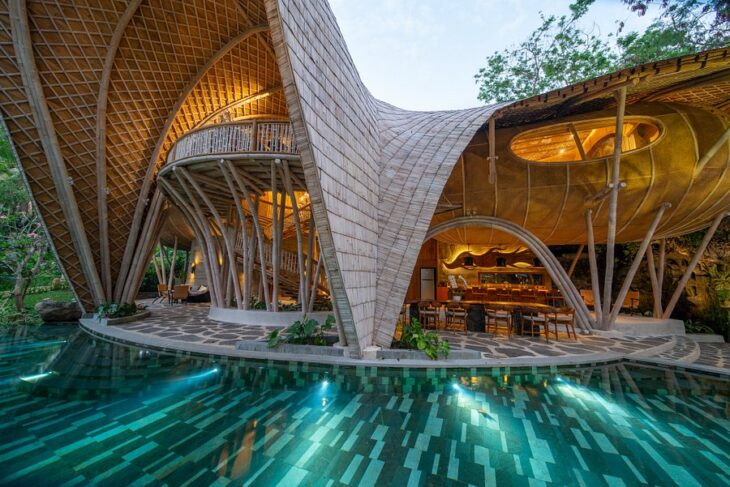
Balinese architectural buildings are known for their uniqueness throughout the world. Many architects are ultimately inspired by architectural buildings in Bali. One of the recommended best architecture firms in Bali is Arkana Architecture which has created many designs for famous buildings in Bali.
Currently, buildings in Bali have followed technological developments. So in several new buildings in Bali, the architectural design has been combined with modern design but still maintains traditional Balinese elements.
Reviewing Facts about Balinese Architectural Buildings
The uniqueness of Balinese architecture that makes it famous throughout the world cannot be separated from the rich philosophy and culture that influences it. To get to know more about the uniqueness of Balinese architecture, consider the following interesting facts.
Balinese Architecture is Influenced by 7 Philosophies
Seven philosophies reflect Balinese architecture, including:
- Tri Hata Karana: reflects the balance of the 3 elements of life, namely: atma (human), khaya (god), and angga (nature).
- Tri Mandala: regulates the layout of the room.
- Sanga Mandala: determining the location and position of Balinese architecture.
- Tri Angga: arrangement of spatial concepts that are closely related to other natural worlds.
- Tri Loka: a building concept for balance between the three realms.
- Asta Kosala Kosali: a concept consisting of eight aspects, such as shape, size, location, arrangement, direction, material, ornament, and color.
- Arga Segara: building arrangement based on cardinal directions.
Using Traditional Measurement Methods
Traditional Balinese architectural buildings were previously built using traditional measurement methods based on units of measurement for building occupants. The traditional units of measurement are:
- Aug: a knuckle,
- Alek: along the middle finger,
- Akacing: along the index finger,
- Fathom: the size of two hand spans from left to right,
- Hasta: an inch of distance from the middle wrist to the tip of the middle finger with an open palm,
- Musti: fist size, thumb facing up,
and there are still several other traditional Balinese units of measurement.
Space Zoning Using the Sanga Mandala Concept
The space zoning arrangement for traditional Balinese architecture uses the Sanga Mandala concept. The building will be divided into 3, including the main, middle, and lower buildings to determine the function of each room.
Home Yard Arrangement Regulations
One part that is mandatory in traditional Balinese architecture is the yard, usually located in the middle of the building complex. The following are the rules and restrictions that you need to pay attention to:
- Karang Kalebon Amuk: water droplets from the roof of other people’s houses must not be entered.
- Karang Kalingkuhan: not in the middle of other people’s yards or houses.
- Karang Negen: must not be right next to a highway.
- Ngeluanin Pura: not adjacent to the eastern or northern part of the temple, unless there is land separating it.
- Numbak Rurung: not located in the “skewer” position.
Of all the recommended best architecture firms in Bali, Arkana Architecture is one of the firms capable of creating Balinese architecture buildings by paying attention to the things above. They can also add modern or other cultural elements without destroying the philosophy and rules of traditional Balinese architecture.
Reviewing the Masterpieces of Balinese Architectural Buildings
Most of the buildings in Bali are miracles in terms of their distinctive design. Some of the following Balinese architectural buildings are impressive masterpieces, from ancient to contemporary places.
Tanah Lot
Tanah Lot is a tourist spot that can provide the beauty of Balinese architecture found in Hindu temples on the beach. You can see from the shape of the roof and the entire temple building that it is very enchanting as the embodiment of a masterpiece of traditional Balinese architecture.
Ulun Danu Beratan Temple
Ulun Danu Beratan is a temple located on Lake Beratan in the Bedugul area with stunning natural views. This temple exhibits Balinese architecture with original essence and is located right in the center of Bali. From this temple, you can see the temples of Brahma, Shiva, Vishu, and Loh Batu artifacts.
Gunung Kawi Temple
Gunung Kawi Temple is an embodiment of the beauty of Balinese architecture as well as an archaeological site full of history. There are ancient temple carvings on rocky cliffs that are fed by well-planned water channels.
Natural elements were also used in the construction of this temple, as applied to other Balinese architecture. You can see the embodiment of this natural element on the temple terrace which is filled with extensive green plants.
Lempuyang Temple
It is one of the oldest temples located in East Bali. Lempuyang Temple is believed to have been built in Bali before other Hindu holy places. This unique Balinese architecture has 1700 steps with unique carvings and carvings. The view at the top of the stairs is amazing, you will see a panoramic view of East Bali filled with cool green forest views.
Oberoi Villa
Oberoi Villa is located in Ubud Bali. This villa building adopts natural elements with “living in nature”. The architect who designed this building is Arkana Architecture, one of the recommended best architecture firms in Bali. Even though it is a modern building, the Oberoi Villa was built with natural materials such as those used for traditional Balinese architectural buildings, namely bricks and wood.
Every aspect of architecture in Bali has great respect for its cultural heritage. However, currently Balinese architecture is flexible in accepting integration with modern elements. If you are interested in having a building that combines Balinese architecture and modern design, Arkana Architecture is one of the recommended best architecture firms in Bali!



